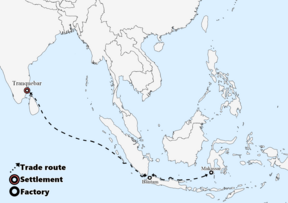Sieges of Tranquebar (1655–1669)
| Sieges of Tranquebar | |
|---|---|
Tranquebar, (modern-day Tamil Nadu, india) 11°1′45″N 79°50′58″E / 11.02917°N 79.84944°E | |
| Result | Dano-Portuguese victory |
| Territorial changes | Villages of Poreiar, Tillali and Erikutanchery ceded to the Danes |
Few Portuguese
1 ship (1669)
The Sieges of Tranquebar (
Background
In 1643 the vessel Christianshavn would arrive in Tranquebar with proclaimed governor, Willem Leyel.
In 1648 a mutiny broke out in Tranquebar and Leyel was subsequently arrested.[2][6] He was succeeded by Poul Hansen Korsør,[a] who reigned until his death on 7 September 1655.[7] Furthermore, the first Danish East India Company was dissestablished in 1650, and the number of Danes remained only a handful.[8]
Arriving together with the Christianshavn in 1643,
Sieges
The Nayak of the Thanjavur kingdom, Vijaya Raghava, had waged war against the Gingee and Madurai and therefore needed sufficient money.[8] The Thanjavurians took advantage of a weakened Tranquebar and in 1655 demanded to raise the early tribute paid by Tranquebar.[11][12] When Tranquebar failed to fulfill this demand Raghava sent a force to besiege Tranquebar.[9] Though, Andersen defended the attack by the help of the local Indians: The number of Danish settlers in Tranquebar was very small, and it was therefore necessary to hire Portuguese mercenaries and Indian Sepoys to defend Fort Dansborg.[9]
In 1660 a new siege was initiated, which would last nine months.[9][8] In response Andersen started to fortify the whole town.[13] Previously Dansborg had been the only fortified place, and the Inhabitants of Tranquebar would usually seek shelter in the fort.[12] This was now changed, and all of Tranquebar was fortified.[12] Andersen made the locals build a Curtain wall around the city, with four additional towers.[8]
In May 1669 the 29-year-isolation was over with the arrival of the frigate Farø at Tranquebar.[9][11] Færø arrived with soldiers and goods under the command of Henrik Eggers.[10] As a result of Færø's arrival peace was concluded with Vijaya Raghava.[11]
Aftermath
As a result of the peace the nayak ceded the villages of Poreiar, Tillali and Erikutanchery, which greatly enlargened Tranquebar.[11] Meanwhile, Færø would be sent to Java to reestablish trade connections with the local sultan.[11]
See also
- Willem Leyel's siege of Dansborg – Siege of Fort Dansborg, 1644
- Ambush near the Bay of Manila – Ambush of Danish and Dutch sailors in the Philippines, 1645
- Tillali Massacre – Massacre and Battle in Tillali, India 1756
- Dano-Mughal War – Danish colonial conflict against the Mughal Empire
Notelist
References
- ^ Sejerø, Olav. "Trankebarmønter med Skibsnavne". sejeroe.com. Retrieved 2024-04-18.
- ^ a b c Bredsdorff, Asta (2009). The Trials and Travels of Willem Leyel. Copenhagen: Museum Tusculanum Press.
- ^ a b "Tranquebar-mønter, 1620-1670". danmarkshistorien.dk (in Danish). Retrieved 2024-04-18.
- ^ "Danmarks koloni i Tranquebar 1616-1729 - Rigsarkivet - kilderne.dk". Kilderne (in Danish). Retrieved 2024-04-18.
- ^ a b Ritzau (2020-10-17). "Eskild var den eneste dansker i Trankebar". Sjællandske Nyheder (in Danish). Retrieved 2024-04-18.
- ^ Holbek, Finn. "Skeel, Schaffalitzky og Ahlefeldt". finnholbek.dk (in Danish). Retrieved 2024-04-18.
- ^ "P. H. Korsør - www.foreningen-trankebar.dk". 123hjemmeside.dk (in Danish). Retrieved 2024-04-18.
- ^ a b c d "Eskild alene i Tranquebar". videnskab.dk (in Danish). 2023-06-14. Retrieved 2024-04-18.
- ^ a b c d e f g "Den danske tropekoloni i Trankebar". www.aerenlund.dk. Retrieved 2024-04-18.
- ^ a b "E.A.Kongsbakke - www.foreningen-trankebar.dk". 123hjemmeside.dk (in Danish). Retrieved 2024-04-18.
- ^ ISBN 9788711978337.
- ^ a b c "Bogstaver på Frederik den Tredies blymønter". danskmoent.dk. Retrieved 2024-04-18.
- ^ Westerbeek, Bjørn. Omkring et par tidlige kort over Tranquebar (in Danish). Københavns Rådhusbibliotek. p. 28.

